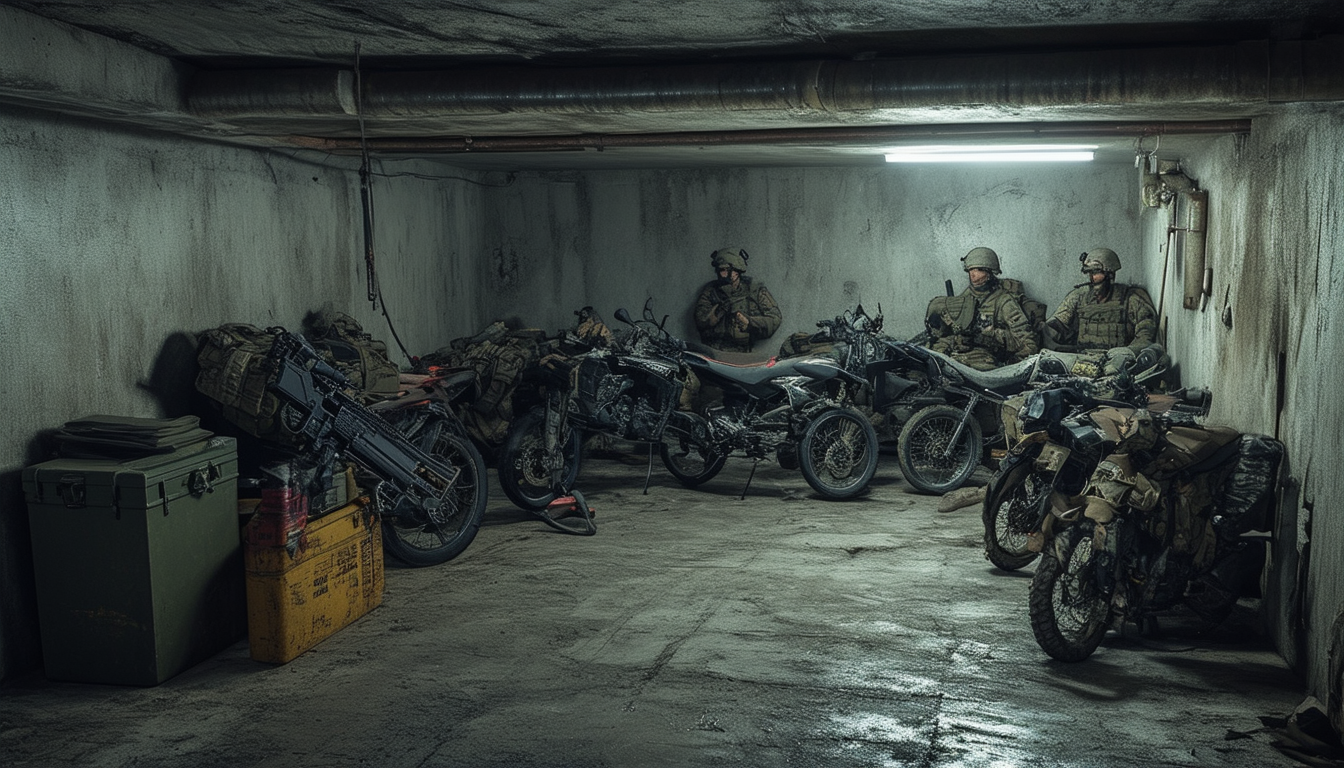Israel Unveils Hezbollah’s Concealed Terrorist Stronghold: A Hidden Bunker Packed with Weapons and Motorcycles Under a Residential Home

In a significant revelation, Israel has uncovered a hidden bunker belonging to Hezbollah beneath a residential home near the Lebanon border. This concealed stronghold was stocked with weapons and motorcycles intended for planned attacks against Israeli targets. The discovery raises serious concerns about the ongoing threat posed by the terrorist organization, highlighting its intent to strike deeper inside Israel using fortified positions, all while hiding behind civilian structures.
Israel Unveils Hezbollah’s Concealed Terrorist Stronghold
In a troubling discovery, Israeli authorities have unveiled a hidden bunker belonging to Hezbollah, located beneath a residential house in a Lebanese village near the border. This compound was reportedly stocked with weapons and motorcycles, which were intended for planning attacks against Israel. The revelation of this clandestine operation sheds light on the ongoing security concerns in the region and highlights the persistent threats posed by militant organizations.
Details of the Bunker Discovery
The Israel Defense Forces (IDF) announced the findings through spokesperson Rear Adm. Daniel Hagari. In a detailed briefing, he explained that the bunker was part of Hezbollah’s operations, specifically designed for their special forces, the Radwan Forces. Intelligence sources indicated that this facility was instrumental in planning raids into Israeli territory with the intent to cause significant casualties, mirroring the scale of previous attacks.
Weapons and Preparations for Attack
Inside the bunker, Israeli troops discovered an extensive cache of weapons and ammunition. The IDF’s footage revealed these dangerous materials laid out across makeshift beds, suggesting a preparation for imminent military action. The presence of motorcycles in the compound further indicates that the group had designed tactical operations aimed at penetrating Israeli defenses swiftly.
The Implications of Hezbollah’s Activities
Hagari emphasized the urgency of the situation, noting that Hezbollah was planning a series of assaults within Israel, with the aim to inflict greater damage than previous incidents, particularly referencing the horrifying events of October 7th. He described the compound as a critical hub for coordinating efforts against Israeli citizens, highlighting the serious threat that Hezbollah continues to pose despite ongoing military operations aimed at disrupting their activities.
The Threat of Hezbollah and Its Leadership
The notorious former Hezbollah leader, Hassan Nasrallah, who was recently killed in an Israeli airstrike, left behind a dangerous legacy. Israel’s defense officials have classified him as a “ruthless terrorist” who orchestrated numerous attacks resulting in countless lives lost, not only among Israelis but also targeting international civilians. This recent discovery underscores the repercussions of letting such groups operate unchallenged.
Strategic Military Actions by the IDF
In response to the ongoing threat, the IDF has intensified its military operations along the northern border, focusing on dismantling Hezbollah’s infrastructures. These operations have involved intelligence-gathering missions, direct engagement with Hezbollah compounds, and the destruction of weapons caches. The aim is to ensure the safety of Israeli citizens and prevent any future assaults.
Conclusion on the Situation
The uncovered bunker serves as a stark reminder of the persistent threats in the region. It highlights not just the military dangers posed by Hezbollah, but also the broader implications for regional stability. As the IDF continues its operations against such militant threats, the focus remains on maintaining security for Israel and its citizens against hidden and persistent dangers.
Recently, Israel’s military unveiled a concealed Hezbollah bunker located beneath a residential home in a Lebanese village. This underground facility was stocked with weapons and motorcycles, which were reportedly intended for future attacks against Israel. The discovery highlights ongoing security concerns regarding terrorist groups operating near national borders.
Details of the Bunker Discovery
The Israeli Defense Forces (IDF), represented by Rear Adm. Daniel Hagari, reported significant findings inside the bunker, which included an array of ammunition and firearms spread across beds and other areas. In addition to the weapons, there were indications of recent occupancy, such as fresh food and coffee, along with a notable portrait of a former Hezbollah leader.
Implications for Regional Security
The presence of a terrorist stronghold so close to Israel’s border raises critical questions about regional security and the ongoing threat posed by Hezbollah. The IDF has indicated that the bunker was intended to facilitate a large-scale attack against Israeli citizens, underscoring the organization’s strategic planning for future operations.
Motorscyles and Their Role in Attacks
One striking element of the bunker was the presence of motorcycles, meticulously arranged for use in potential assaults. These vehicles can enable terrorists to traverse terrain quickly and evade detection while executing their plans, making them a valuable asset for any terrorist organization.
Hezbollah’s Intentions
The IDF has stated that the organization intended to conduct a massacre on a scale larger than past attacks, indicating a disturbing escalation in their operational strategy. This has prompted the Israeli military to enhance its readiness and take action to neutralize threats posed by Hezbollah activities.
The discovery of the bunker emphasizes the complexity of ensuring security against groups like Hezbollah, which utilize civilian environments to establish hidden military infrastructures. As tensions remain high, the situation poses a continuous challenge for Israel and its defense strategies.






